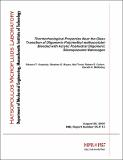| dc.description.abstract | Two distinct oligomeric species of similar mass and chemical functionality
(Mw ≈ 2,000 g/mol), one a linear methyl methacrylate oligomer (radius of gyration Rg ≈ 1.1 nm) and the other a hybrid organic-inorganic polyhedral silsesquioxane nanocage (methacryl-POSS, r ≈ 1.0 nm), were subjected to thermal and rheological tests to
compare the behaviors of these geometrically dissimilar molecules over the entire
composition range. The glass transition temperatures of the blends varied monotonically between the glass transition temperatures of the pure oligomer (Tg = −47.3°C) and the pure POSS (Tg = −61.0°C). Blends containing high POSS contents (with volume fraction φ_POSS ≥ 0.90) exhibited enhanced enthalpy relaxation in DSC measurements, and the degree of enthalpy relaxation was used to calculate the kinetic fragility indices m of the oligomeric MMA (m = 59) and the POSS (m = 74). The temperature dependences of the viscosities were fitted by the free volume-based WLF-VFT framework and a dynamic scaling relation. The calculated values of the fragility from the WLF-VFT fits were similar for the POSS (m = 82) and for the oligomer (m = 76), and the dynamic scaling exponent was similar for the oligomeric MMA and the POSS. Within the range of known fragilities for glass-forming liquids, the temperature dependence of the viscosity was found to be similarly fragile for the two species. The difference in shape of the nanocages and oligomer chains is unimportant in controlling the glass-forming properties of the blends at low volume fractions ( φPOSS < 0.20); however, at higher volume fractions, adjacent POSS cages begin to crowd each other, leading to an increase in the fractional free volume at the glass transition temperature and the observed enhanced enthalpy relaxation in DSC. | en |
